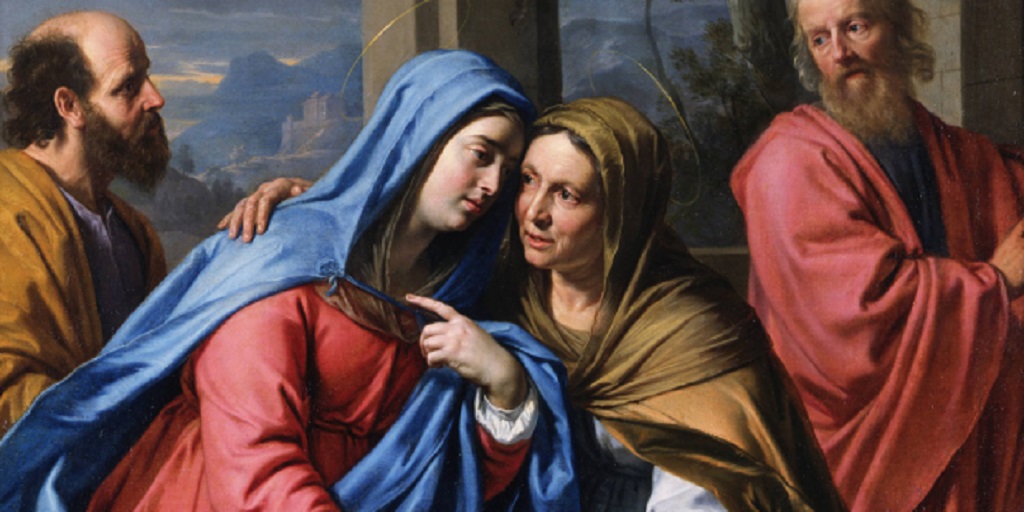Mgr Domenico Sguaitamatti
Mary set out and went with haste: this simple, but fundamental annotation of Luke on Mary’s attitude is the element that does not allow us to think that the Visitation is something different from the Annunciation, as if they were two separate events. It is true that from the historical point of view they take place in different localities, in different times, the protagonists are different and liturgy itself celebrates the two feasts separately on two different days. However, in their salvific significance, the two events are strictly bound to each other, to such an extent, that the Visitation is considered to be the fulfilment of the Annunciation itself, because for Mary it constitutes the tangible ‘sign’ that the words of the Angel are true and they are the ‘sign of God’ for her: «And now, your relative Elizabeth in her old age has also conceived a son; and this is the sixth month for her who was said to be barren».
Hence, this is what Mary longs for and it is also her need, I dare say, to verify and to touch this ‘sign’, which makes her stand up right away and to go hastily to visit Elizabeth. Of course, she goes hastily to show her loving care and fraternal charity, but most of all she goes hastily to encounter the ‘sign’ because she wants to give trustworthiness and foundation to her «yes» declared with great trust, open heartedness and freedom to God. The womb, pregnant and visible of Elizabeth, leads Mary to acknowledge clearly that God’s project for her is not an impossible promise, but a certainty that cannot be denied.
Ancient art has often dealt with this particular subject, highlighting the truthfulness of the encounter. Particularly meaningful is the gesture with which Elizabeth is normally portrayed: Mary joyfully embraces her cousin Elizabeth who, while exchanging the greeting, touches gently Mary’s womb with her hand, underlining that she is already ‘touching the mystery’, and she is the first to reveal and witness the truthfulness. The mother seems to anticipate the mission and the function of her son, the precursor: «Here is the Lamb of God who takes away the sin of the world»; the leaping of the child in the womb of the mother, already in the sixth month, is a confirmation.
Hence, if at the Annunciation the angel is the voice of the divine promise, here Elizabeth is the confirmation of God’s working. This is the sense of the greeting of Elizabeth who, filled with the same Spirit, first bursts in a blissful and enthusiastic admiration regarding Mary: «Blessed are you among women, and blessed is the fruit of your womb», then she asks: «And why has this happened to me, that the mother of the Lord comes to me?» and finally she reaches the height of the beatitude, the first that the Gospels report: «And blessed is she who believed that there would be a fulfilment of what was spoken to her by the Lord».
Mary recognizes the sign and Elizabeth’s child does not only leap, but he leaps joyfully in his mother’s womb. Mary visited Elizabeth in order ‘to believe’, to root and to give foundation to that «Yes» through which she had promised and entrusted herself to God; she came to encounter and embrace the ‘sign’ that God prepared for her. Only at this point, only here Mary does truly and totally belong to God and, in the splendid hymn of the Magnificat, she identifies, and joyfully recognizes the works that God is accomplishing in her, as the result of her believing in the words of the angel and her free and responsible self-giving to God: «Let it be with me according to your word».
The Magnificat is the hymn which exalts ‘God’s coming’ in her womb. The Visitation is the feast of the ‘sign’ for Mary, but also of the ‘sign’ that we are all called to be, in force of the Baptism, which filled us with grace and Holy Spirit, so that all those who meet us, for any reason, may revive their believing or, perhaps, stimulate them to recoup their faith, or to start a new journey leading them close to the mystery of the love of God.
God’s charity is the ‘visitation’ with which he encounters, reveals himself and embraces man and woman, so we ought to be credible ‘signs’ for our brethren. Also we are called to be ‘God bearers’, so that our encounter with the brothers may be more and more a ‘God’s visitation to man and woman’. We are called to generate true charity, not a two-faced charity, and to practice it in daily life and in common things; charity that is able to give a new and different, surprising zest to our relationships, that can become contagious seed of good, truth, beauty and justice.
Mary is also the Virgin in prayer. She appears as
such in the visit to the mother of the precursor,
when she pours out her soul in expressions glorifying
God, and expressions of humility, faith and hope.
This prayer is the Magnificat (cf. Lk1:46-55),
Mary’s prayer par excellence, the song of the messianic times
in which there mingles the joy of the ancient and the new Israel.
As St Irenaeus seems to suggest, it is in Mary’s canticle
that there was heard once more the rejoicing of Abraham
who foresaw the Messiah (cf. Jn 8:56) and there rang out
in prophetic anticipation the voice of the Church:
In her exultation Mary prophetically declared in the
name of the Church: My soul proclaims the glory of the Lord.
And in fact Mary’s hymn has spread far and wide and
has become the prayer of the whole Church in all ages.
(PAUL VI, Marialis Cultus, 18)
From NSDU 2018-3, pp.

